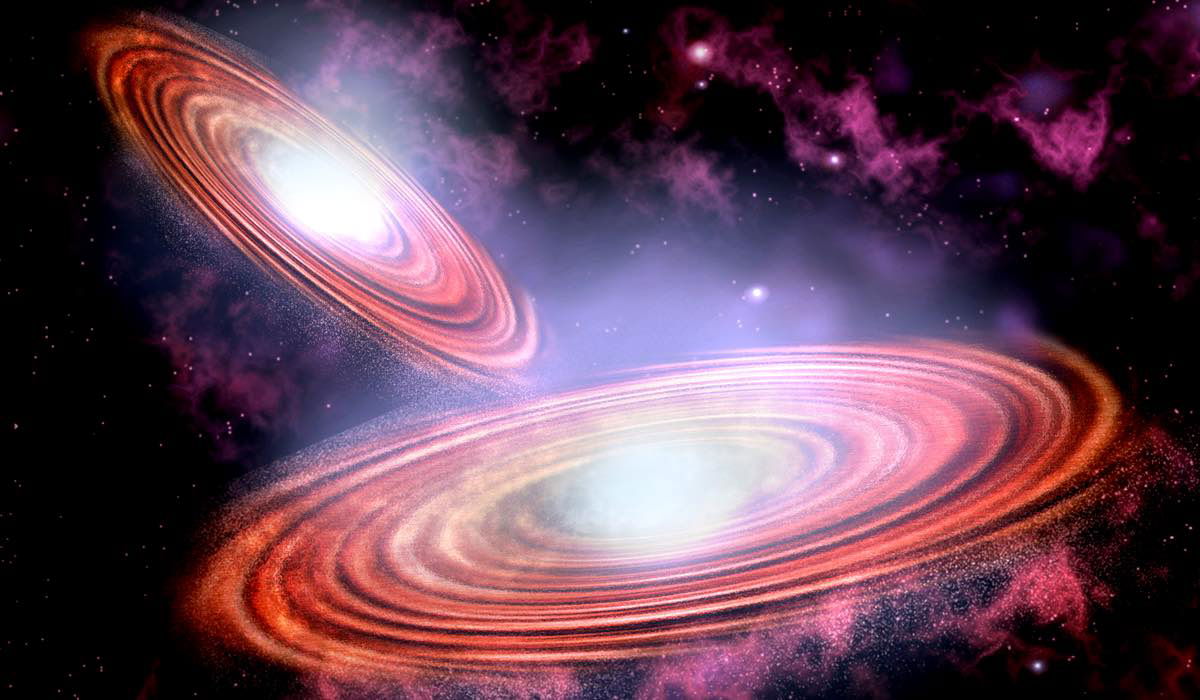New research suggests that black hole mergers may produce smaller black hole “morsels” that emit distinctive gamma-ray bursts (GRBs), which could help astronomers detect Hawking radiation using current telescopes.
Decades ago, physicist Stephen Hawking proposed that a hypothetical form of thermal black-body radiation would be emitted beyond a black hole’s event horizon. This concept seems to contradict what we know about black holes since nothing, including light, can escape their intense gravity.
However, in 1974, Hawking theorized that an extremely faint form of radiation would exist beyond a black hole’s event horizon, resulting from one particle in every particle-antiparticle pair being captured. Although Hawking demonstrated this concept in theory, he presumed the resulting radiation would be too faint to be detectable by even the best telescopes.
Today, Hawking radiation remains only a hypothetical byproduct of the physics of black holes, as it has never been directly observed. However, an international team consisting of researchers Giacomo Cacciapaglia, Stefan Hohenegger, and Francesco Sannino now says that phenomena associated with black hole mergers may indeed allow Hawking radiation to be perceived using contemporary telescopes.
Black hole mergers produce phenomena the research team calls black hole “morsels,” which are created during catastrophic astrophysical events. These morsels may produce high-energy particles that could be detectable as gamma-ray bursts (GRBs).
Direct images of regions near supermassive black holes captured in recent years help showcase their immense gravitational effects. Stellar mass black holes, formed by the death of extremely massive stars, produce gravitational waves that have been observed with the Laser Interferometer Gravitational-Wave Observatory (LIGO) and the European Gravitational Observatory’s Virgo interferometric antenna.
In theory, smaller black holes, such as those formed early in the universe, could produce Hawking radiation in detectable ranges. While black holes lighter than a few solar masses are not predicted to be formed during such stellar collapses, it is theorized that they may occur resulting from other events, including quantum space-time fluctuations during inflationary periods.
In their recent study, the team focused on how black hole morsels are produced during mergers between black holes, which are a byproduct of non-linear gravitational fields that are present during mergers. These, in theory, would emit Hawking radiation, producing GRBs with a distinctive fingerprint.
Black hole mergers are detectable through the gravity waves they emit but can also produce GRBs if preexisting material is present around them at the onset of the merger. Simulations have also shown that the phenomenon of gravitational non-linearity is present during mergers, particularly during what astrophysicists call the “ringdown” phase.
Based on such black hole dynamics, the team theorizes that emissions generated by black hole morsels could provide a unique mechanism for high-energy particle emission. With help from numerical simulations based on the BlackHawk code, a public resource for calculating Hawking radiation, black hole morsels would likely emit photons and neutrinos that are detectable on Earth through mechanisms such as fluctuations in photons generated by some black hole mergers.
The field of multimessenger astrophysics, which has to do with gravitational waves and their electromagnetic counterparts, is a component of the current studies being conducted with LIGO and Virgo, as well as Japan’s Kamioka Gravitational Wave Detector (KAGRA) program. The HESS telescope, monitoring photon energies between 1 and 10 TeV, has placed constraints on the energy flux from black hole mergers.
Based on such observations, atmospheric Cherenkov telescopes like HESS, among others, should, in theory, be detectable by the emission of black hole morsels during mergers.
Under some conditions, supermassive black hole mergers could produce even greater black hole morsels with equally more intense GRBs. Photons from these may offer astrophysicists steady sources of signals that outlast other astrophysical sources for such detections.
The team believes their study of black hole morsels formed from mergers could provide a novel avenue for detecting high-energy GRBs, allowing astrophysicists to better evaluate the underlying physics of black holes.
Additionally, such observations could help reveal new insights into particle physics, clues about the formation of black holes, and an overall improvement in our understanding of these and other enigmatic objects throughout our universe.
Cacciapaglia, Hohenegger, and Sannino’s new paper, “Measuring Hawking Radiation from Black Hole Morsels in Astrophysical Black Hole Mergers,” was uploaded to the preprint arXive.org server and can be read online.
Micah Hanks is the Editor-in-Chief and Co-Founder of The Debrief. He can be reached by email at micah@thedebrief.org. Follow his work at micahhanks.com and on X: @MicahHanks.

